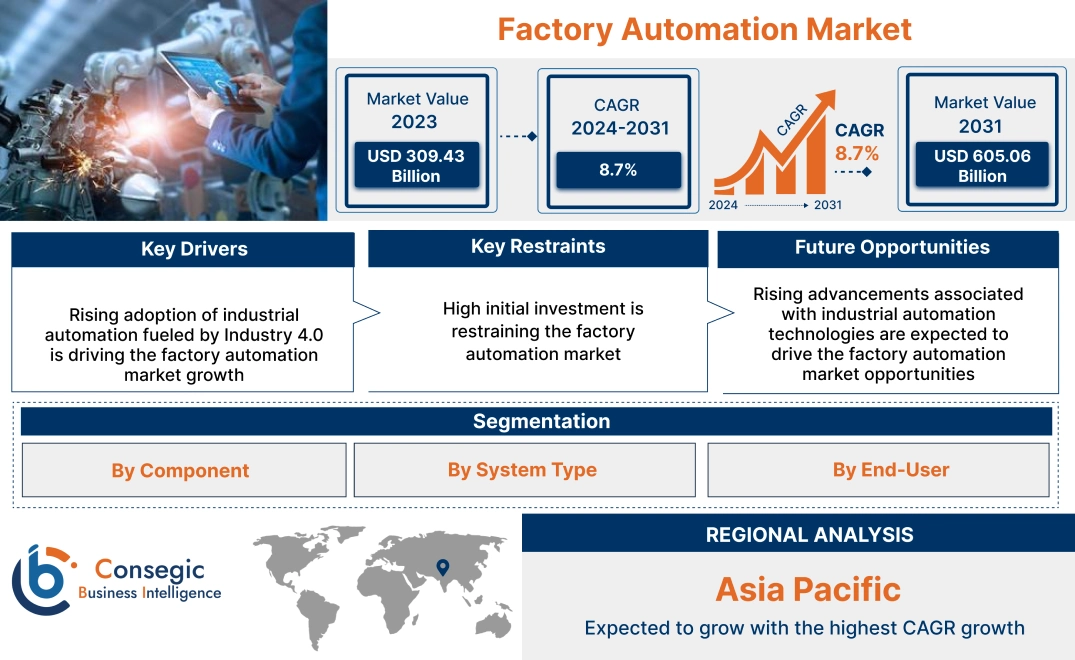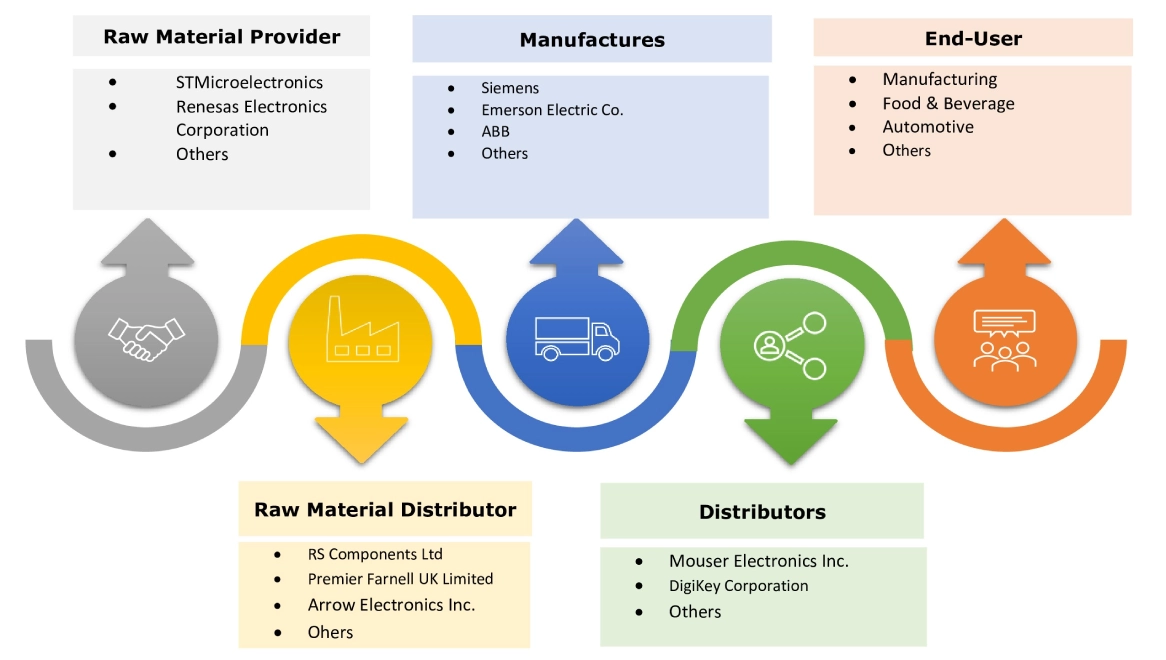- Summary
- Table Of Content
- Methodology
Factory Automation Market Size:
Global Factory Automation Market size is estimated to reach over USD 605.06 Billion by 2031 from a value of USD 309.43 Billion in 2023 and is projected to grow by USD 334.87 Billion in 2024, growing at a CAGR of 8.7% from 2024 to 2031.
Factory Automation Market Scope & Overview:
Factory automation refers to the utilization of automation technologies for end-to-end manufacturing processes. It incorporates a broad range of technologies including robotics, control systems, information technologies, and data analytics, for enhancing the productivity and efficiency of manufacturing processes. Moreover, it also offers a range of benefits such as increased operational efficiency, cost reduction, increased flexibility, scalability, enhanced labor utilization, and others.
Factory Automation MarketDynamics - (DRO) :
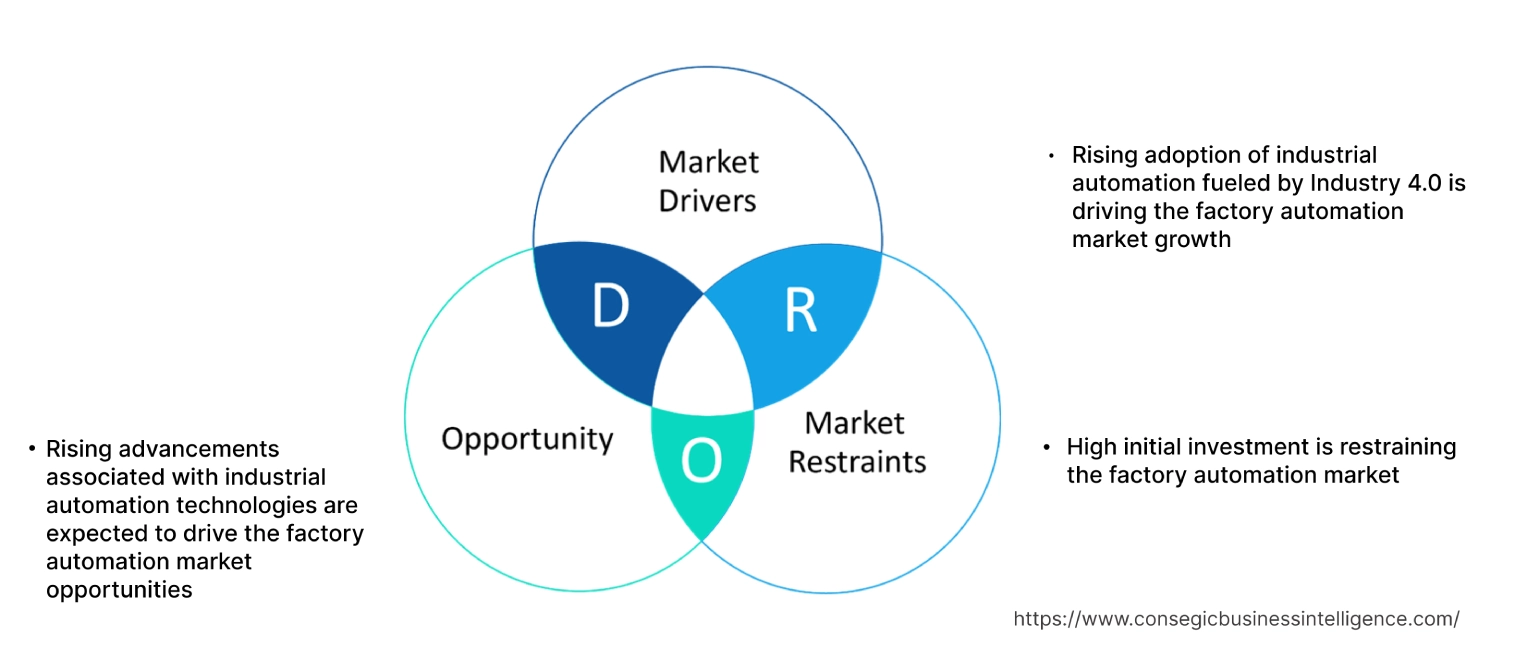
Key Drivers:
Rising adoption of industrial automation fueled by Industry 4.0 is driving the factory automation market growth
Industry 4.0-enabled manufacturing represents automation readiness, extreme flexibility, minimal human intervention, and the highest productivity. Moreover, factory automation enables 24/7 production capabilities, minimizing downtime and maximizing throughput. Manufacturing companies are increasingly focused on improving operational efficiency, and factory automation technologies help achieve this by streamlining processes. Additionally, the use of automated systems in factories can analyze workflows and optimize operations, helping manufacturers to become more agile and responsive to market demands. The utilization of automation technologies in factories offers numerous benefits including faster processes, high accuracy & precision, improved worker safety, and improved operational efficiency.
- For instance, in July 2024, Xiaomi launched its completely automated smart factory in Beijing, China. The automated factory spans across 860,000 square feet and it is developed to manufacture approximately 10 million smartphones each year without any human intervention.
Thus, the rising adoption of industrial automation in manufacturing facilities is driving the factory automation market size.
Key Restraints :
High initial investment is restraining the factory automation market
High initial investment associated with setting up automation systems in factories is among the primary factors restraining the market growth. The upfront costs associated with the acquisition of automation hardware/equipment, and software, along with integrating them into existing systems can be significantly high, which may cause financial barriers, particularly for smaller businesses or businesses operating on tighter budgets.
Additionally, automation systems can be quite complex to install and integrate, which further necessitates additional expenses on training personnel or hiring specialized experts to implement and maintain the automated systems effectively. Hence, the high initial investment associated with setting up automation systems in factories is hindering the factory automation market expansion.
Future Opportunities :
Rising advancements associated with industrial automation technologies are expected to drive the factory automation market opportunities
Industrial automation providers are frequently investing in the development of new technologies including hardware and software solutions to ensure their safe and effective utilization in manufacturing facilities for enhanced operational efficiency and minimal human intervention.
- For instance, in May 2023, Renishaw, a global engineering technology company, introduced its new RCS product line that is specifically designed for industrial automation. The new RCS product line aims to transform the process of commissioning and servicing industrial automation technologies. It focuses on challenges related to manual set-up, calibration, and maintenance of robots within industrial facilities.
Thus, as per the factory automation market analysis, rising advancements associated with industrial automation technologies are anticipated to drive the factory automation market opportunities.
Factory Automation Market Segmental Analysis :
By Component:
Based on components, the market is segmented into hardware, software, and services.
Trends in the component:
- Increasing technological advancements associated with industrial automation devices such as robotics systems, sensors, controllers, and others.
- There is a rising trend of industrial automation devices in factories for constant monitoring, optimization, and improved operational efficiency.
The hardware segment accounted for the largest revenue share of 56.45% of the total factory automation market share in 2023.
- The primary hardware components include programmable logic controllers (PLCs), industrial robots, sensors, actuators, motors, and others
- PLCs are industrial computers used to control machinery and processes automatically. Industrial robots are used for automating repetitive tasks in factories for increased precision and efficiency.
- Moreover, the aforementioned hardware components help in facilitating automation within factories, in turn leading to improved efficiency, precision, and safety in manufacturing processes.
- For instance, in August 2024, Okuma America Corporation launched its new ORL series of robotics for facilitating automation within factories. The ORL series includes three products, which are optimized to seamlessly load and unload workpieces from both new and pre-existing Okuma machines for increasing productivity and aiding operators' efficiency.
- According to the analysis, the rising innovations associated with hardware components for facilitating automation within factories are driving the factory automation market growth.
The software segment is anticipated to register the fastest CAGR growth during the forecast period.
- Factory automation software provides a centralized platform for monitoring and controlling the automation systems used within factories. The software has the ability to capture, organize, and analyze data to monitor factory equipment and system performance.
- Moreover, the benefits of integrating industrial automation software include smarter maintenance and effective analysis of factory equipment performance.
- In October 2022, Schneider Electric launched EcoStruxure Automation Expert v24, its next-generation industrial automation software. The upgraded industrial automation software is capable of supporting larger industrial plants and additional communication protocols.
- Therefore, the increasing advancements associated with automation software are anticipated to boost the factory automation market size during the forecast period.
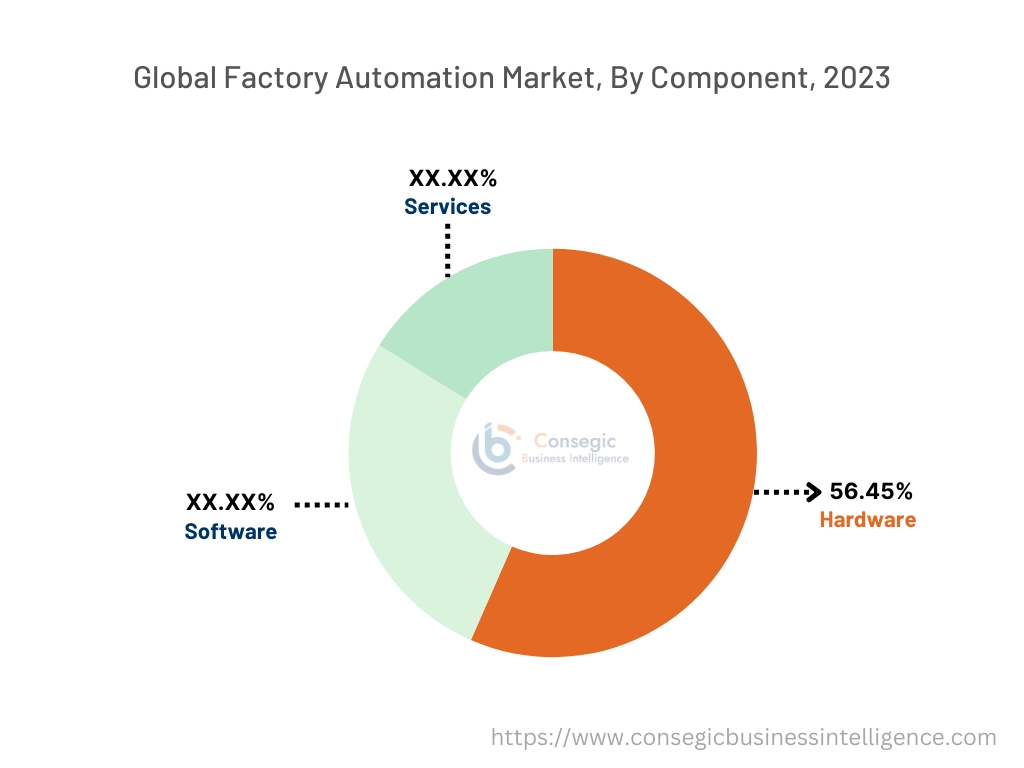
By System Type:
Based on system type, the market is segmented into fixed automation, flexible automation, programmable automation, and integrated automation.
Trends in the system type:
- There is an increasing trend towards the adoption of fixed automation systems within factories for performing repetitive tasks with minimal effort to increase operational efficiency.
- Rising adoption of programmable automation in industries where the tasks can vary from one batch to another batch.
The fixed automation segment accounted for the largest revenue in the overall factory automation market share in 2023, and it is anticipated to register a significant CAGR during the forecast period.
- Fixed automation system refers to the simplest type of industrial automation system.
- In fixed automation systems, the machines are permanently set up for performing a particular task. Upon completion of the task, the machines are then reset and typically wait to perform the next task.
- Moreover, fixed automation systems are primarily utilized for discrete mass production or constant flow systems. An example of a fixed automation system includes an automated conveyor belt that is designed to move objects with minimum effort while increasing efficiency.
- For instance, in May 2024, Montech, a Swiss technology company, launched its new belt conveyor line designed for utilization in cleanrooms. The belt conveyors are tested and certified for application in cleanrooms and can be utilized in multiple industries including pharmaceutical, chemical, semiconductor, and others.
- Therefore, the rising developments associated with fixed automation systems are driving the factory automation market trends.
By End-User Industry:
Based on the end user, the market is segmented into manufacturing, food & beverage, pharmaceuticals, automotive, and others.
Trends in the end user:
- Industrial factories have seen a significant growth trend in the utilization of automation systems for optimizing and streamlining industrial processes.
- The prevalence of favorable government initiatives for industrial automation is driving the growth of the manufacturing segment.
The manufacturing segment accounted for the largest revenue share of the total market share in 2023, and it is anticipated to register the fastest CAGR during the forecast period.
- This dominance is attributed to the rising adoption of industrial automation systems in manufacturing factories for optimizing manufacturing processes and operations with minimal human intervention.
- Additionally, the increasing development of smart factories and technological advancements in manufacturing equipment such as artificial intelligence (AI) has further propelled the market expansion.
- For instance, in December 2023, Mitsubishi Electric India introduced its new smart manufacturing facility for advanced factory automation systems in the state of Maharashtra, India. The new manufacturing facility is optimized to deliver products with the highest quality and reliability while strengthening its business in India and addressing the increasing demand for advanced automation and smart manufacturing solutions.
- According to the analysis, the rising developments associated with smart factories and the adoption of automation in manufacturing facilities are driving the factory automation market growth.
Regional Analysis:
The regions covered are North America, Europe, Asia Pacific, the Middle East and Africa, and Latin America.
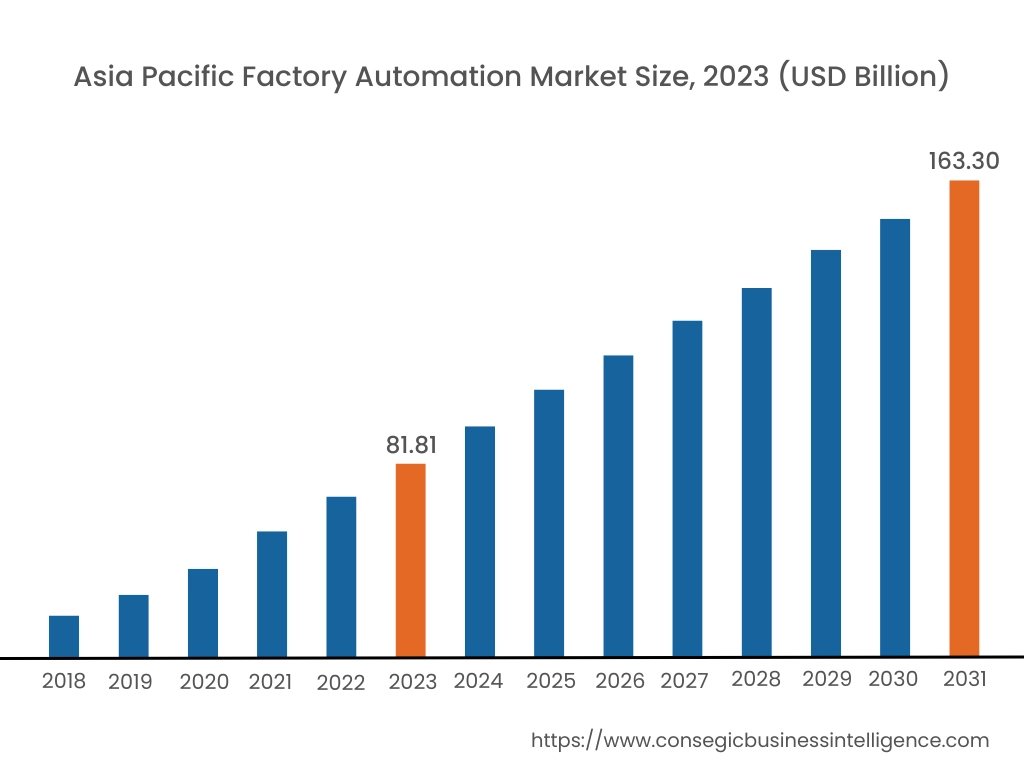
Asia Pacific region was valued at USD 81.81 Billion in 2023. Moreover, it is projected to grow by USD 88.69 Billion in 2024 and reach over USD 163.30 Billion by 2031. Out of this, China accounted for the maximum revenue share of 33.6%. As per the factory automation market analysis, there is increasing adoption of factory automation, particularly in countries such as China, India, and Japan for improved operational efficiency. Additionally, increasing advancements associated with smart factory solutions are further accelerating the factory automation market expansion.
- For instance, in September 2024, Panasonic Smart Factory Solutions India launched its advanced smart factory solutions and products that are integrated with technologies such as IIoT (industrial internet of things), AI (artificial intelligence), automation, and others. These innovations are optimized to integrate with manufacturing processes seamlessly, in turn driving quality, efficiency, and production capacity to exceptional levels.
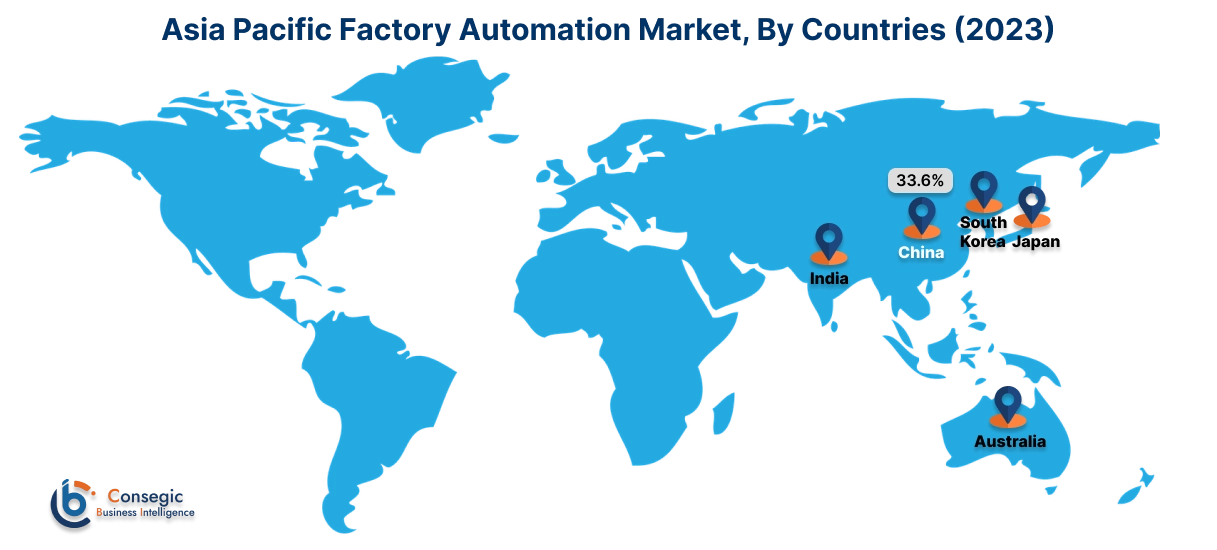
North America is estimated to reach over USD 206.44 Billion by 2031 from a value of USD 105.30 Billion in 2023 and is projected to grow by USD 113.98 Billion in 2024. In North America, the growth of the factory automation industry is driven by the rising adoption of industrial automation and the increasing development of smart factories in the region. Similarly, the rising investment in the development of industrial manufacturing facilities is contributing to the factory automation market demand.
- For instance, in March 2022, Kerry Group, a food and beverage company, invested USD 137 million in the development of its new food manufacturing facility in Georgia, United States. The rising development of manufacturing facilities is increasing the integration of automation solutions within factories, thereby, driving the factory automation market trends in North America.
The regional analysis depicts that the prevalence of favorable government measures for facilitating industrial automation and the increasing development of industrial factories is driving the factory automation market demand in Europe. Further, as per the market analysis, the market demand in Latin America, the Middle East, and African regions is expected to grow at a considerable rate due to increasing investments in the development of industrial manufacturing facilities and the rising adoption of industrial automation solutions within factories.
Top Key Players & Market Share Insights:
The global factory automation market is highly competitive with major players providing services to the national and international markets. Key players are adopting several strategies in research and development (R&D), product innovation, and end-user launches to hold a strong position in the global factory automation market. Key players in the factory automation industry include -
- Siemens (Germany)
- Emerson Electric Co. (United States)
- Rockwell Automation Inc. (United States)
- OMRON Corporation (United States)
- General Electric (United States)
- Mitsubishi Electric Corporation (Japan)
- ABB (Switzerland)
- Honeywell International Inc. (United States)
- KUKA AG (Germany)
- Schneider Electric (France)
Recent Industry Developments :
Product Launches:
- In September 2024, Schneider Electric introduced its new ultra-compact Lexium Scara in its industrial automation portfolio. Lexium Scara is a high-speed industrial robot that can be deployed across several industries including battery manufacturing, warehousing, electronics, and consumer packaging goods among others.
- In August 2024, Okuma America Corporation launched its new ORL series of robotics that is designed for facilitating automation within factories, increasing productivity, and aiding operators' efficiency.
- In October 2022, Schneider Electric launched EcoStruxure Automation Expert v24, its next-generation industrial automation software. The upgraded industrial automation software is capable of supporting larger industrial plants and additional communication protocols.
Factory Automation Market Report Insights :
| Report Attributes | Report Details |
| Study Timeline | 2018-2031 |
| Market Size in 2031 | USD 605.06 Billion |
| CAGR (2024-2031) | 8.7% |
| By Component |
|
| By System Type |
|
| By End-User |
|
| By Region |
|
| Key Players |
|
| North America | U.S. Canada Mexico |
| Europe | U.K. Germany France Spain Italy Russia Benelux Rest of Europe |
| APAC | China South Korea Japan India Australia ASEAN Rest of Asia-Pacific |
| Middle East and Africa | GCC Turkey South Africa Rest of MEA |
| LATAM | Brazil Argentina Chile Rest of LATAM |
| Report Coverage |
|
Key Questions Answered in the Report
How big is the factory automation market? +
The factory automation market was valued at USD 309.43 Billion in 2023 and is projected to grow to USD 605.06 Billion by 2031.
Which is the fastest-growing region in the factory automation market? +
Asia-Pacific is the region experiencing the most rapid growth in the factory automation market.
What specific segmentation details are covered in the factory automation report? +
The factory automation report includes specific segmentation details for component, system type, end user, and region.
Who are the major players in the factory automation market? +
The key participants in the factory automation market are Siemens (Germany), Emerson Electric Co. (United States), Mitsubishi Electric Corporation (Japan), ABB (Switzerland), Honeywell International Inc. (United States), KUKA AG (Germany), Schneider Electric (France), Rockwell Automation Inc. (United States), OMRON Corporation (United States), and General Electric (United States).
